 |
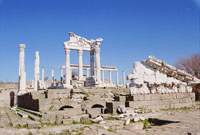 |
|
After the death of Alexander the Great, one of his generals who is called Lysimachus chose Pergamum as the depository for his wealth. He placed nine thousand talents of gold in Pergamum under the guardianship of Philetaerus who was his lieutenant. After the death of Lysimachus, Philetaerus took advantage of this wealth and founded the independent dynasty of Attalid Kings which later became the center of Hellenistic civilization. |
|
| With the success of the two kings Attalus I and Eumenes II, Pergamum reached the highest point of its power. However during those time Rome and the Hellenistic leaders united. |
|
| After that Pergamum became a very powerful kingdom by Attalus I including Mysia, Lydia, Caria, Pamphylia and Phrygia. He not only extended the borders but also decorated the capital city with architectural splendors. Eumenes II improved the city culturally. King Attalus III bequeathed the territory to the Romans who made the city rich in art and culture poor in politics and economy. The city went through the Arab, Byzantine and finally the Turkish period in the 14C. |
|
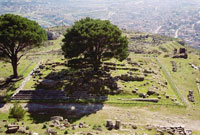 |
|
| In Hellenistic period the ancient city made an intellectual progress with the famous sculpture school and public buildings and monuments. Also Pergamum played an important role during the reign of the Romans. |
|
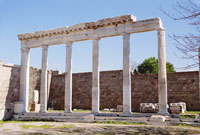 |
|
The foundation of acropolis in Pergamum depended on social and cultural activities which we can consider it to be the daily life. Because of this, buildings in Pergamum were designed to be used in daily life. More than religion socialization was important as a proof even the temples were one of the meeting places of people where they can join in social affairs just like other large buildings which were designed for this purpose. |
|
| Pergamum had the fame to be the first city who showed reaction to the functional urbanism of Hippodamus as they preferred ornamental urbanism. Acropolis buildings were built and designed with the aim of impressing the ones viewing the city from the valley. |
|
| All buildings except the Trajan Temple were built in the reign of the Hellenistic emperors which are mostly made of andesite and rarely marble. Heroon in Pergamum was the shrine in which the kings especially Attalus I and Eumenes II were worshipped. Eumenes II built the Sanctuary of Athena, dedicated to victory-bringing, in Pergamum which was entered through a propylon. The entrance of the Sanctuary is surrounded by three stoas of the Doric order which opens to a courtyard. |
|
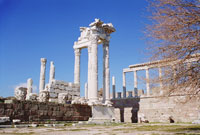 |
|
| Athena Temple is located at the corner near the theatre in Doric order as well which was built earlier. Another building constructed by Eumenes II is the Library of Pergamum. |
|
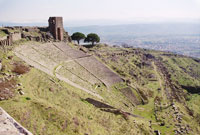 |
|
It was the second of the three famous ancient libraries which contained two hundred thousand volumes and which were given to Cleopatra a century later as a wedding present by Mark Antony to be added to the ones in the library of Alexandria. The library is located north of the Athena Sanctuary. The Library of Pergamum was rich in sources but when the Egyptians prohibited the export of papyrus, Pergamum King ordered a new material to be found which can take the place of papyrus. |
|
| What they found was called parchment which was a material made of sheep or goat skin. It was polished first with pumice stone and then slit into sheets. Because of this, the word parchment is used as a synonym of the name Pergamum>. In the 2nd century Hadrian who was the successor of Trojan have the Temple of Trojan built in Pergamum in Corinthian order and dedicated it to Trojan itself. It was built of marble. |
|
| The Theatre of Pergamum is said to be the steepest raked Hellenistic theatre in the world. The cavea of the theatre consists of eighty rows of seats is divided into three sections by two diazomas. The theatre is designed for ten thousand people in which and the site was used to construct. One can see the typical Hellenistic characteristics of a theatre. Firstly it had no permanent stage building and people were able to see outside and beyond the playing area from where they were seated. |
|
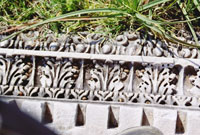 |
|
| Zeus Altar can be accepted as the finest altar ever built. It was built in 180BC without a temple which is unusual. The altar which is a marble offering-table is on a huge stone plinth which also supports the double colonnade of Ionic columns. |
|
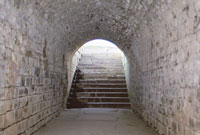 |
|
Asclepion
Asclepion translates as 'place of Aesklepios', the son of Apollo and the god of healing and health, and was an important health center in Greco-Roman times. Among the types of therapy practiced here were mud baths, sports, theatre, psychotherapy and use of medicinal waters. |
|
| A colonnaded street leads to the Asclepion, and to the left of the entrance is the temple of Asclepios. This domed temple with its exceptionally thick 3m walls was built in 150 AD, with donations made to the god of health. The interior was decorated with colorful marble mosaics, and surrounded by galleries on three sides, the Asclepion has a passageway running through the center alongside the sacred spring towards the therapy building. |
|
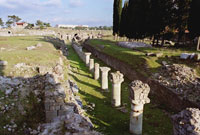 |
|
| It is thought that patients were cured here by the sound of running water and by the persuasive hypnotic techniques used by the priests. |
|
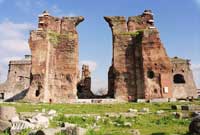 |
|
The Temple of Serapis - The Red Basilica
The biggest structure and best-known attraction in the town is the Kizil Avlu (Red Basilica), a temple made of red brick dedicated to the gods of Egypt. The temple lies in what is now the modern day town of Bergama. The two pools in the temple with towers indicate ritual cleansing rites and a religious background that was neither Greek |
|
|
nor Roman. The fact that it faces west, and is decorated with statues in an Egyptian style, indicates that it was possibly presented to Serapis, the Egyptian god of the underworld. In the Byzantine period, it was turned into a church by extensive remodeling, especially to the apse sections, and was dedicated to the St. John. |
|
| In early Christianity, it was one of the Seven Churches of Asia Minor addressed by St. John in the Book of Revelation, who referred to it as the throne of the Devil. Although a crumbling ruin, it still contains the remains of a mosque in one of the towers. |
|
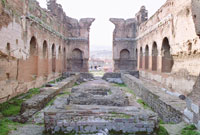 |
|
|
 |
|
|
|
|
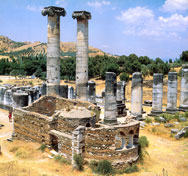 |
|
|
|
Turkey, the second holy land. Follow the footsteps of St. Paul in Turkey and the Seven Churches of Asia Minor. A must pilgrimage for all the Christians and true believers. |
|
|
|
|
|
 |
|